Franklin Mountains State Park
| Franklin Mountains State Park | |
|---|---|

Entrance to Tom Mays unit
|
|
| Nearest city | El Paso |
| Coordinates | 31°53′01″N 106°30′08″W / 31.88361°N 106.50222°WCoordinates: 31°53′01″N 106°30′08″W / 31.88361°N 106.50222°W |
| Length | 23 mi (37 km) |
| Width | 3 mi (4.8 km) |
| Area | 24,247 acres (98.12 km2) |
| Elevation | 5,426 ft (1,654 m) |
| Designated | 1987 |
| Named for | Benjamin Franklin Coons |
| Administrator | Texas Parks and Wildlife |
| Website | TPWD website |
Franklin Mountains State Park is a Texas state park in El Paso, Texas, in the United States. Park headquarters are located at an elevation of 5,426 feet (1,654 m) with the highest peak reaching 7,192 feet (2,192 m). It is the largest urban park in the nation lying completely within city limits, covering 24,247.56 acres (9,813 ha). Franklin Mountains State Park is open year-round for recreational hiking, mountain biking, picnicking and scenic driving and vistas.
Native Americans and other travellers have used the natural resources in the Franklin Mountains when crossing the gap between the Franklin Mountains and the Juarez Mountains that is now Ciudad Juárez across the Rio Grande in Mexico and El Paso. Pictograms and mortar pits confirm a human presence in the mountains dating back more than 12,000 years.
The Franklin Mountains are most likely named for Benjamin Franklin Coons, who in 1849 purchased a ranch in what is now El Paso. At first known as Coons Ranch, by 1851 the settlement took on Coons' middle name and was called Franklin. Despite the town being officially named El Paso in 1852, the locals continued to call it Franklin throughout the 1850s.
The El Paso Tin Mining and Smelting Company operated a tin mine on the northeast slope of North Franklin Mountain from 1909–1915. While the mine had the distinction of being the only tin mine ever located in the U.S., it was an economic failure.
Efforts to grant protected status to the Franklin Mountains began as early as 1925. A real estate developer sought to build housing on the mountains and in 1979 he built a road up into them. A local organization known as the Wilderness Park Coalition was to convince the Texas Legislature to protect the mountains in 1979. Despite this success the legislature, in the same bill, prohibited funding for the development, operation and maintenance of the park. The property was formally acquired in 1981. Changes to the legislation were made in 1985 when a plan for park development was established and the park was opened to the public in 1987.
...
Wikipedia

